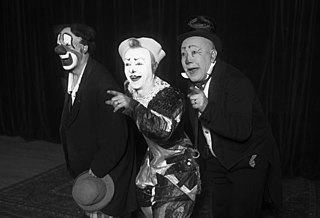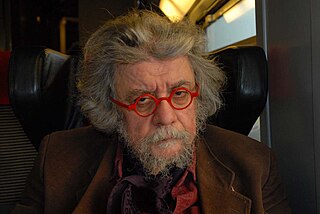 W
WAntoine Mandelot, better known as Bobèche, was a French theatre clown, similar to a Merry Andrew, under the First Empire and the Restoration.
 W
WCha-U-Kao was a French entertainer who performed at the Moulin Rouge and the Nouveau Cirque in the 1890s. Her stage name was also the name of a boisterous popular dance, similar to the can-can, which came from the French words "chahut", meaning "noise" and "chaos". She was depicted in a series of paintings by Henri de Toulouse-Lautrec. Cha-U-Kao soon became one of his favorite models. The artist was fascinated by this woman who dared to choose the classic male profession of clowning and was not afraid to openly declare that she was a lesbian.
 W
WChocolat was the stage name of Rafael Padilla, a clown who performed in a Paris circus around the turn of the 20th century. Rafael was of Afro-Cuban descent and was one of the earliest successful black entertainers in modern France. He was the first black clown to play a lead role in a circus pantomime act, and with his longtime partner George Foottit they revolutionized the art of clowning by pairing the sophisticated white clown with the foolish auguste clown.
 W
WJean-Charles Deburau was an important French mime, the son and successor of the legendary Jean-Gaspard Deburau, who was immortalized as Baptiste the Pierrot in Marcel Carné's film Children of Paradise (1945). After his father's death in 1846, Charles kept alive his pantomimic legacy, first in Paris, at the Théâtre des Funambules, and then, beginning in the late 1850s, at theaters in Bordeaux and Marseille. He is routinely credited with founding a southern "school" of pantomime; indeed, he served as tutor to the Marseille mime Louis Rouffe, who, in turn, gave instruction to Séverin Cafferra, known simply as "Séverin". But their art was nourished by the work of other mimes, particularly of Charles's rival, Paul Legrand, and by earlier developments in nineteenth-century pantomime that were alien to the Deburaux' traditions.
 W
WPierre Étaix was a French clown, comedian and filmmaker. Étaix made a series of short- and feature-length films, many of them co-written by influential screenwriter Jean-Claude Carrière. He won an Academy Award for best live action short film in 1963. Due to a legal dispute with a distribution company, his films were unavailable from the 1970s until 2009.
 W
WThe Fratellini Family was a famous European circus family in the late 1910s and 1920s. An engagement at the Circus Medrano in Paris, France, after World War I was so successful that it sparked a strong resurgence of interest in the circus. By 1923, the Fratellini brothers had become the darlings of the Parisian intellectuals. They were lauded in print and worshiped by adoring fans who would show up at the circus just in time for the Fratellini entree, which sometimes ran as long as forty-five minutes.
 W
WAnnie Violette Fratellini was a French circus artist, singer, film actress and clown.
 W
WFrançois Fratellini (1879-1951) was a French circus clown. He performed as an elegant Whiteface. He was a member of the Fratellini Family. François was born in Paris, in 1879, and died there in 1951. He had two brothers: Paul Fratellini and Albert Fratellini.
 W
WPhilippe Gaulier is a French master clown, pedagogue, and professor of theatre. He is the founder of École Philippe Gaulier, a prestigious French theatre school in Étampes, outside Paris. He studied under Jacques Lecoq in the mid-1960s and was an instructor at L'École Internationale de Théâtre Jacques Lecoq in the late 1970s. As well as performing as a clown, he is also a playwright and director. He has published The Tormentor, a book discussing his thoughts on the theatre and containing exercises designed to develop an actor's skill.
 W
WMarcel Marceau was a French actor and mime artist most famous for his stage persona, "Bip the Clown". He referred to mime as the "art of silence" and he performed professionally worldwide for over 60 years. As a Jewish youth, he lived in hiding and worked with the French Resistance during most of World War II, giving his first major performance to 3,000 troops after the liberation of Paris in August 1944. Following the war, he studied dramatic art and mime in Paris.
 W
WPierrot is a stock character of pantomime and commedia dell'arte whose origins are in the late seventeenth-century Italian troupe of players performing in Paris and known as the Comédie-Italienne; the name is a diminutive of Pierre (Peter), via the suffix -ot. His character in contemporary popular culture—in poetry, fiction, and the visual arts, as well as works for the stage, screen, and concert hall—is that of the sad clown, pining for love of Columbine, who usually breaks his heart and leaves him for Harlequin. Performing unmasked, with a whitened face, he wears a loose white blouse with large buttons and wide white pantaloons. Sometimes he appears with a frilled collaret and a hat, usually with a close-fitting crown and wide round brim, more rarely with a conical shape like a dunce's cap. But most frequently, since his reincarnation under Jean-Gaspard Deburau, he wears neither collar nor hat, only a black skullcap. The defining characteristic of Pierrot is his naïveté: he is seen as a fool, often the butt of pranks, yet nonetheless trusting.
 W
WAchille Zavatta was a French clown, artist and circus operator.